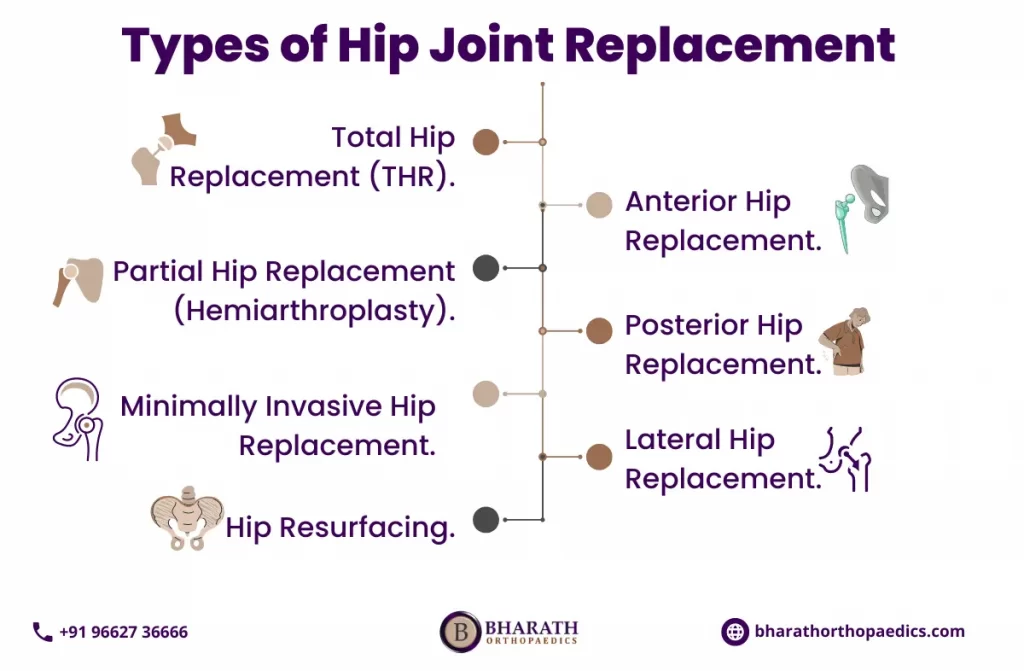Hip joint replacement, also known as hip arthroplasty, is a surgical procedure that involves replacing a damaged or diseased hip joint with an artificial implant to restore function and relieve pain. This procedure is commonly performed in individuals with severe hip joint conditions, such as osteoarthritis, rheumatoid arthritis, avascular necrosis, and hip fractures. Hip joint replacement in Chennai is considered one of the most successful and transformative surgeries, providing significant improvement in the quality of life for many patients.
What is a hip joint replacement?
A hip joint replacement, also known as hip arthroplasty, is a surgical procedure where a damaged or diseased hip joint is replaced with an artificial implant, known as a prosthesis. This procedure aims to relieve pain, restore mobility, and improve function in the hip joint. During the surgery, the surgeon removes the damaged femoral head (the ball-shaped top of the thigh bone) and damaged cartilage from the hip socket (acetabulum), and replaces them with artificial components made of metal, ceramic, or plastic. Hip joint replacement is typically performed for conditions such as osteoarthritis, rheumatoid arthritis, and hip fractures that cause significant pain and mobility limitations.
Candidates for Hip Joint Replacement
People who experience chronic hip pain and disability due to conditions that affect the hip joint may be candidates for hip joint replacement. Common indications for hip joint pain treatment in Chennai include:
- Osteoarthritis: A degenerative joint disease that wears away the protective cartilage, causing pain, stiffness, and limited mobility.
- Rheumatoid Arthritis: An autoimmune condition that inflames the joint lining, leading to pain, swelling, and eventual joint damage.
- Avascular Necrosis: A condition where the blood supply to the femoral head is disrupted, leading to bone death and joint collapse.
- Hip Fractures: Severe fractures of the hip joint often require replacement if other treatments cannot restore normal function.
- Other hip joint conditions causing chronic pain and impairment require hip joint replacement in Chennai.

Check out Exercise for Joint Pain in Old Age.
Best hip joint replacement surgeon in Chennai
Dr. L. Bharath is renowned as one of the best hip joint replacement surgeons in Chennai. With a specialization in orthopedic surgery and a focus on advanced joint replacement techniques, Dr. Bharath has earned a reputation for excellence. He is known for his expertise in minimally invasive procedures and fast-track recovery protocols, having successfully performed numerous hip replacements. Patients benefit from his comprehensive approach, which includes personalized treatment plans and compassionate care, making him a preferred choice for those seeking effective and reliable hip joint replacement surgery in Chennai.
Diagnostic Tests for Hip Joint Replacement
To determine if a hip joint replacement in Chennai is necessary, the specialist will conduct a thorough examination and order diagnostic tests, which may include:
- X-Rays: X-ray images of the hip joint can reveal joint space narrowing, bone spurs, and other signs of joint degeneration or damage.
- MRI (Magnetic Resonance Imaging): MRI scans provide detailed images of soft tissues, cartilage, and ligaments, allowing for a more comprehensive evaluation of the hip joint’s condition.
- CT Scan (Computed Tomography): CT scans offer a three-dimensional view of the hip joint, helpful in assessing complex fractures or deformities.
- Blood Tests: Blood tests taken by hip joint specialists in Chennai can help identify inflammatory markers and rule out other underlying conditions like rheumatoid arthritis.
Treatment Procedures for Hip Joint Replacement in Chennai
- Preoperative Evaluation: Medical history, physical examination, imaging tests (X-rays, MRI), and preoperative tests (blood tests, EKG).
- Surgical Techniques:
- Traditional Hip Replacement: Larger incision, replaces damaged parts with prosthetics.
- Minimally Invasive Hip Replacement: Smaller incisions, less muscle damage, quicker recovery.
- Computer-Assisted Surgery (CAS): Enhanced precision, better alignment.
- Anterior Hip Replacement: Incision at the front, avoids detaching muscles.
- Prosthetic Components: Metal-on-polyethylene, ceramic-on-polyethylene, ceramic-on-ceramic, metal-on-metal.
- Postoperative Care: Hospital stay (3-5 days), pain management, physical therapy, regular follow-up appointments.
Types of Hip Replacement
Total Hip Replacement (THR)
In a THR, the damaged femoral head (the ball of the hip joint) is removed and replaced with a metal or ceramic ball component. The hip socket (acetabulum) is also resurfaced and fitted with a plastic or metal cup component. These artificial components are used for the hip joint pain treatment in Chennai to mimic the natural hip joint’s function, allowing for improved mobility and reduced pain.
Partial Hip Replacement (Hemiarthroplasty)
Hemiarthroplasty involves replacing only the damaged femoral head, leaving the native acetabulum intact. This hip joint replacement in Chennai is commonly performed for hip fractures in older adults when the acetabulum is still relatively healthy.
Minimally Invasive Hip Replacement
Minimally invasive techniques use smaller incisions, causing less tissue disruption and potentially faster recovery. The procedure follows the same principles as a traditional hip replacement but with specialized instruments and approaches.
Revision Hip Replacement
In cases where a previous hip joint replacement in Chennai has failed or worn out, revision surgery may be necessary to replace the prosthetic components. Revision surgeries are often more complex and require specialized expertise.
Signs and Symptoms
- Pain: Persistent ache in the groin, outer thigh, or buttocks.
- Stiffness: Difficulty moving the hip, especially after prolonged sitting or rest.
- Limited Range of Motion: Difficulty in bending or rotating the hip.
- Swelling: Swelling or tenderness that can be seen or felt around the hip joint.
- Grinding Sensation: Feeling of grinding or popping in the hip joint during movement.
- Limping: Altered gait or limping due to pain.
- Locking: Feeling like the hip joint “locks” or gets stuck.
- Radiating Pain: Pain that radiates to the thigh or knee from the hip joint.
Surgical Techniques
- Traditional Hip Replacement: This involves a larger incision to access the hip joint, replace the damaged parts, and install the prosthetic components.
- Minimally Invasive Hip Replacement: This technique uses smaller incisions, resulting in less muscle damage, reduced blood loss, and quicker recovery.
- Computer-Assisted Surgery (CAS): CAS provides enhanced precision in placing the hip components, leading to better alignment and potentially longer-lasting results.
- Anterior Hip Replacement: This approach involves an incision at the front of the hip, allowing the surgeon to work between muscles without detaching them, promoting faster recovery.
What happens after hip replacement surgery?
There is a structured recovery process after hip replacement surgery:
1. Immediate post-op: Monitoring of vital signs in the recovery room.
2. Stay in hospital: Stay for a few days for pain management and initial recovery.
3. Physiotherapy: Start exercises to regain hip mobility and strength.
4. Pain management: Medication to manage post-operative pain.
5. Devices: Use crutches or walkers for support at first.
6. Home recovery: Follow prescribed home exercises and care instructions.
7. Follow-up appointments: Regular check-ups with the surgeon for assessment and adjustments.
8. Gradual Resumption: Resume daily activities gradually, avoiding strenuous tasks.
Following your doctor’s advice will speed up your recovery and ensure improved hip function and reduced pain.
Risks
- Infection: Postoperative infections at the surgical site or deeper within the joint.
- Blood Clots: Risk of blood clots in legs or lungs.
- Dislocation: The hip joint may dislocate, especially in the early postoperative period.
- Leg Length Inequality: Slight difference in leg lengths post-surgery.
- Implant Wear and Loosening: Over time, the prosthetic components may wear out or become loose.
- Fracture: Bone fractures can occur around the implant during or after surgery.
- Nerve Damage: Potential damage to surrounding nerves causing numbness or weakness.
- Allergic Reactions: Adverse reactions to the materials in the implant.
Causes of hip pain
Hip pain can be caused by a number of things, including
- Osteoarthritis: Wear and tear of the joint cartilage.
- Rheumatoid arthritis: Autoimmune inflammation that affects the hip joint.
- Hip fractures: Fractures of the hip bone.
- Bursitis: Inflammation of the fluid-filled sacs around the hip.
- Tendinitis: Inflammation of the hip tendons.
- Hip labral tear: Damage to the cartilage ring (labrum) in the hip socket.
- Muscle or tendon strain: Overuse or injury.
- Hip impingement: Abnormal contact between the hip bones.
- Infection: Infections in the joint can cause pain and swelling.
- Nerve problems: Sciatica or nerve compression.
Accurate diagnosis by a healthcare professional is essential for effective treatment.
Postoperative Care
- Hospital Stay: The typical hospital stay ranges from 3 to 5 days, depending on the patient’s recovery progress.
- Pain Management: Medications are prescribed to manage pain and prevent infections.
- Physical Therapy: A crucial part of recovery, physical therapy begins soon after surgery to improve mobility, strength, and function.
- Follow-Up Appointments: Regular follow-ups with the surgeon to monitor recovery and address any complications.
Conclusion
Hip joint replacement in Chennai is a highly effective treatment option for individuals suffering from severe hip joint conditions that cause chronic pain and disability. With advances in surgical techniques and implant materials, this treatment procedure has become increasingly successful in improving patients’ quality of life. If you are experiencing persistent hip pain treatment or impaired mobility, consult with Dr. L. Bharath at Bharath Orthopaedics to determine if a hip joint replacement is the right solution for you.
Read also Keyhole Surgery in Chennai.




